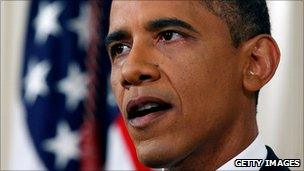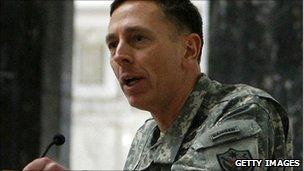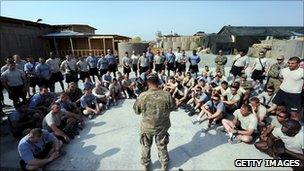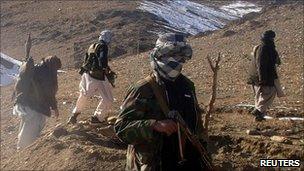Can US cut Afghanistan force without squandering gains?
- Published
- comments

President Obama's 2009 troop surge was always meant to be a temporary measure
US President Barack Obama has taken a key step towards the exit in Afghanistan, while trying to reassure a military leadership that believes now is the wrong time to reduce the pressure on the Taliban.
So by an intricate dance, the American military in Afghanistan will both have to convince their public that they are coming home, and their enemies in the field that they will be pushed hard, not just this summer but next year as well.
Speaking from the White House, Mr Obama said: "It is time to focus on nation building here at home".
While he characterised his intention to pull out more than 30,000 troops by September 2012 as a move conducted from a "position of strength", concerns have been raised by some military commanders about whether this step will reduce the pressure on the insurgency just when it is beginning to tell.
Fighting season
The surge of more than 30,000 combat troops announced by the president in December 2009 was always intended as a temporary measure. It took American numbers in the country from 68,000 to nearly 100,000.

Gen Petraeus argued against cutting fighting units too swiftly wanting more combat units to remain
Military commanders had wanted to keep the insurgents under pressure throughout next summer's "fighting season" as well as this year's.
For this reason, General David Petraeus, the Nato commander, had argued against cutting fighting units too swiftly.
The announcement that all of the surge troops will be gone by September 2012 means that more of the combat forces will have to break off operations during next summer's fight than the general would have liked.
Lieutenant General David Barno, who commanded US forces in Afghanistan during 2003-2005, says the withdrawal of so many soldiers next summer "raises real concerns".
General Lord Dannatt, Britain's former Chief of the General Staff, has characterised the draw down as, "risky".
Opposite view
However, not all serving officers share the view that it is too early to start cutting:
"The fact is that it is time for the Afghans to deliver," one general has told me, "and I'm not sure that we are helping them by maintaining these very large numbers in the south".

A 'logistics' surge has been proposed for 2012 which could temporarily reverse the decline
Something like half of all US forces in the country are in the two southern provinces of Helmand and Kandahar. Reductions from these areas will therefore be significant during the coming year, which may add to the pressure on Britain's forces in central Helmand.
Much will now depend on the management of the cuts. Two issues will concern the military: maintaining combat power for as long as possible and shifting what forces do remain there more to the east of Afghanistan, where the insurgency is still stronger than in the south.
Gen Petraeus would prefer to send support elements home first. But this is where is gets complicated.
In order to get its troops out of Afghanistan, with its poor transport infrastructure, support units such as engineers, transport battalions, and air transport dispatchers will be needed in large numbers.
Gen Petraeus has therefore proposed a "logistics surge" to begin in 2012. That could mean a temporary reverse in the declining numbers, after the presidential elections, as the US begins pulling out the 65,000 or so forces that will remain even after the surge troops have gone.
Early days
Commanders will also try to bolster their forces in the east, even as the overall total falls. The aim of this, like the wider plan, is to maintain military pressure on the insurgents.

A Taliban communique has described the announcement as 'symbolic'
Nightly raids by special forces, aimed at degrading the "irreconcilable" leadership of militant groups will continue at their current high level with the same objective.
Of course, the enemy - as American commanders like to say - "gets a vote too". It will urge supporters and officials of the Kabul government alike to look beyond the next year or two, and the final victory of the insurgency.
Quite how the key players in the insurgency will weigh the certainty of America's eventual departure against the ability of Nato forces to harm them in the meantime is anybody's guess.
However, the characterisation of Mr Obama's announcement in a Taliban communiqué as, "symbolic" is interesting.
It recognises that the bulk of US forces will remain in the country for years, and that it is too early yet to be pronouncing on victory or defeat.